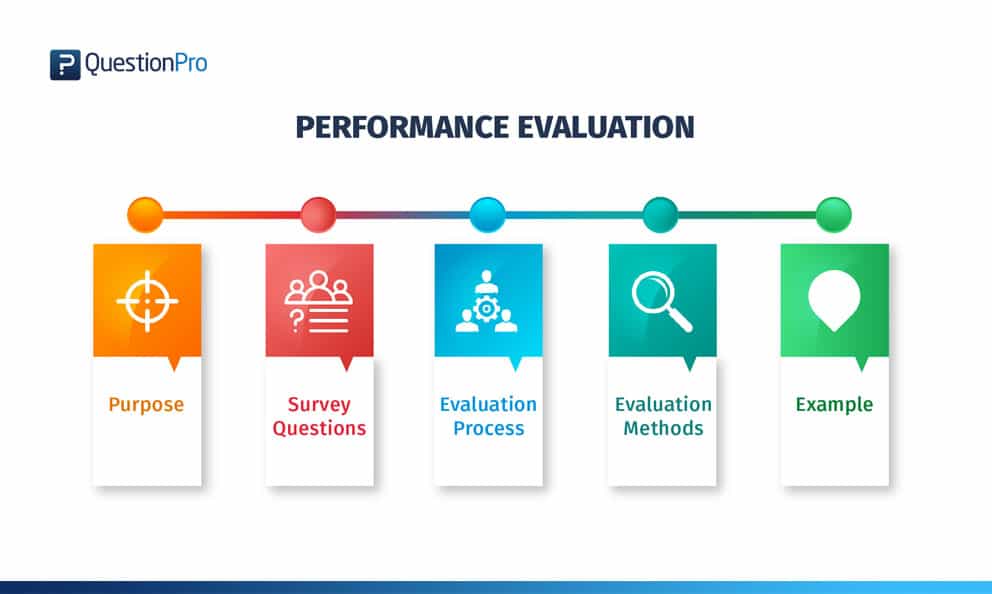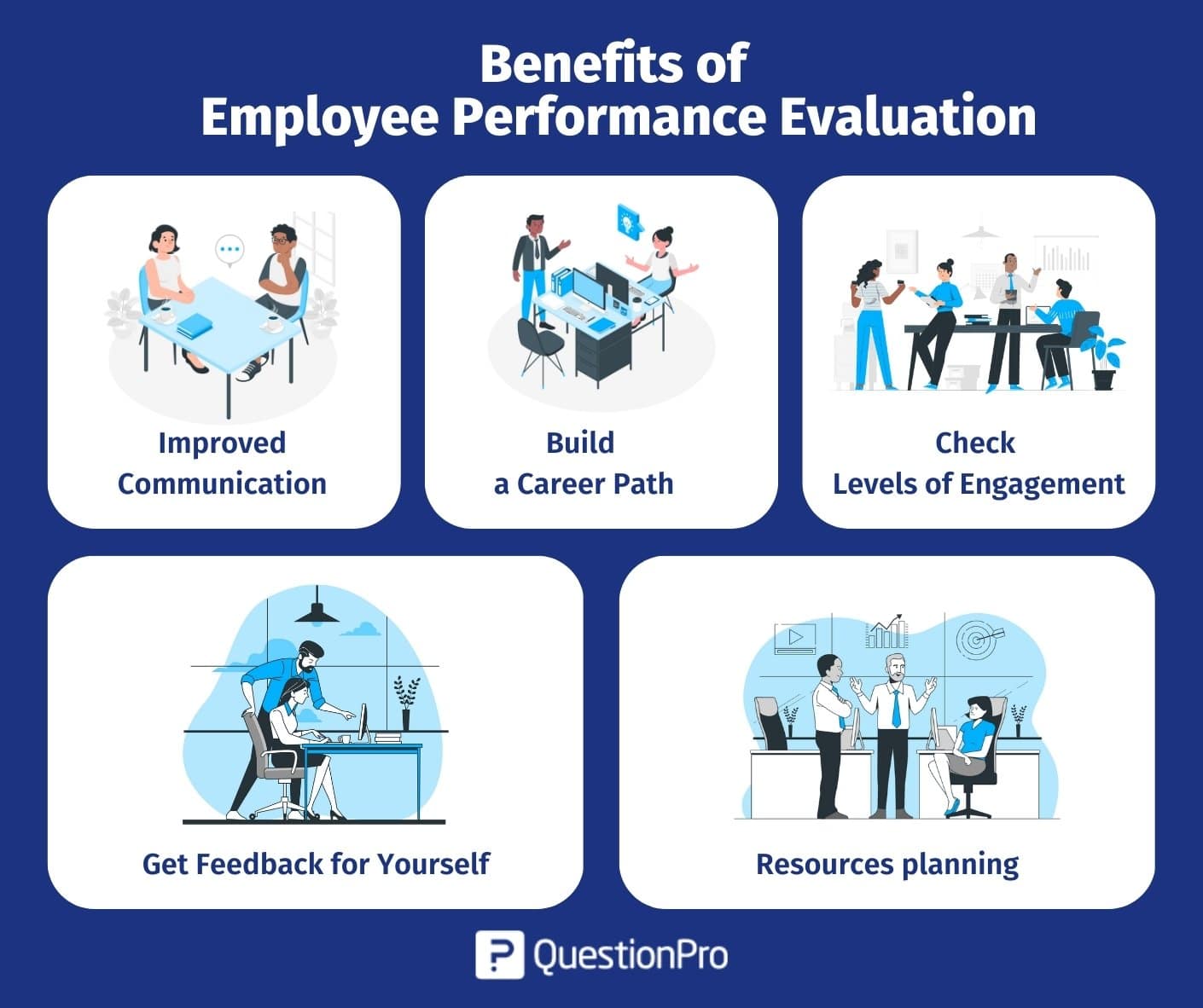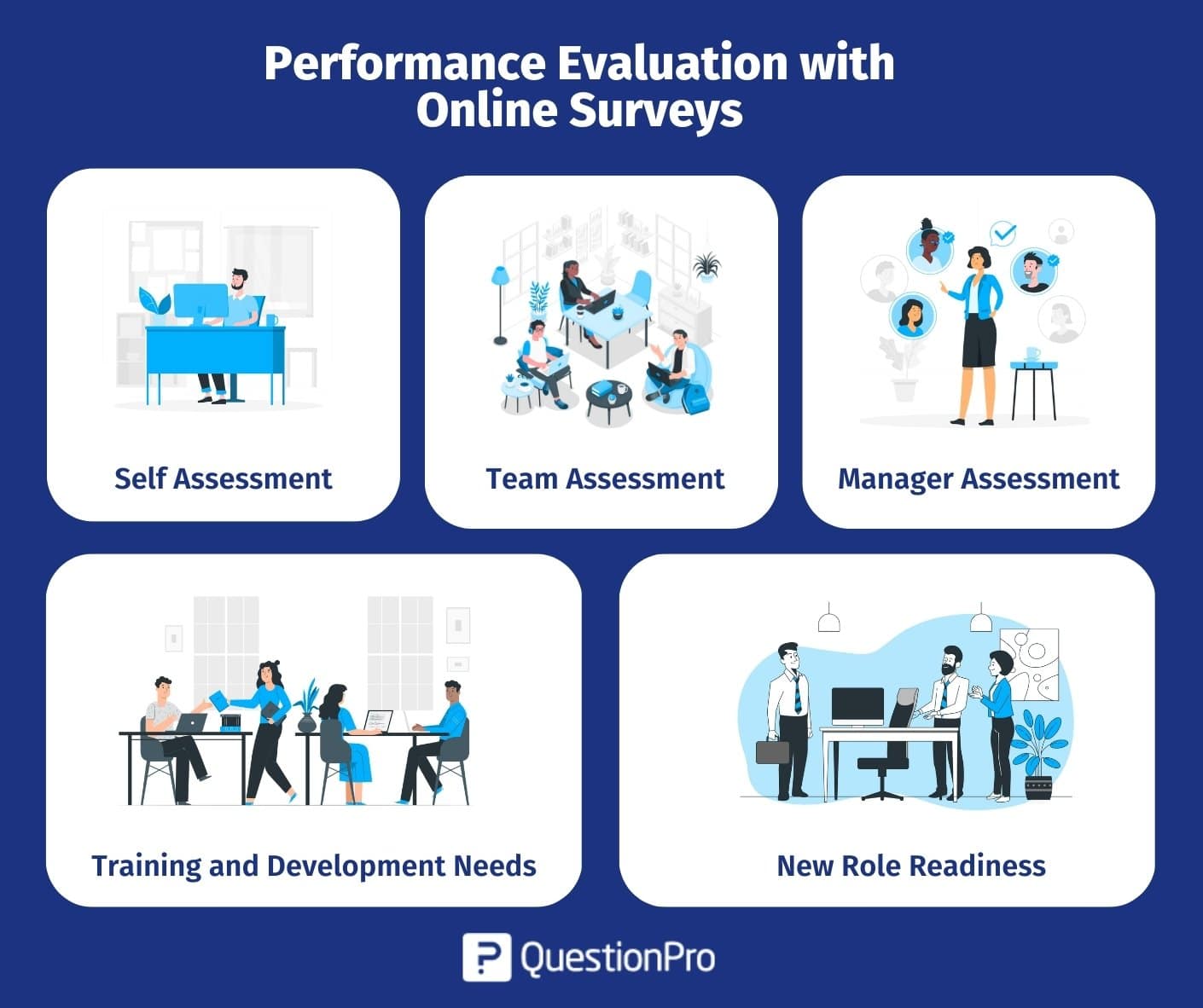

All organizations that have learned the art of “winning from within” by focusing inward on their employees rely on a systematic performance evaluation process to measure and evaluate employee performance regularly.
Ideally, employees have graded annually on their work anniversaries based on which they are either promoted or given suitable distribution of salary raises. Performance evaluation also directly provides periodic feedback to employees, such that they are more self-aware in terms of their employee performance evaluation metrics.
In this blog, we will discuss performance evaluation, its methods, and some survey questions and give you some examples for your better understanding.
Performance Evaluation is defined as a formal and productive procedure to measure an employee’s work and results based on their job responsibilities. It is used to gauge the amount of value added by an employee in terms of increased business revenue compared to industry standards and overall employee return on investment (ROI).
Performance evaluation aims to measure an individual’s or organization’s job performance to determine how well they fulfill their responsibilities. We will learn about some important additional purposes of performance evaluation in this section:
Now that we know why the staff performance measurement process is necessary let us look at the top 5 key benefits the employee performance evaluation offers.

In staff performance evaluation processes, managers give continuous feedback to the team members. This feedback is based on their assignments, their understanding of them, completion, and delivery.
Using this feedback, employees can improve their work and plug any gap areas that have been identified by their managers. It also brings to light many issues that the employees may have and need to be addressed. It helps in open and honest communication between the manager and the team.
Managers help their employees with assignments and how they can effectively do them. A performance evaluation meeting is a perfect time to look at an employee’s career path. It lets the employee know what their future goals are and what they need to do to get there.
It helps them create small and achievable goals, assign deadlines to them, and work towards completion. It also lets the employees know where they stand in the hierarchy and where they will be in the years to come.
Engaged employees perform better than their counterparts. They are better team players, are more productive, and help their peers out actively. A staff performance evaluation is a perfect time to check how engaged an employee is.
It will not only help you understand how engaged the employee is but also let you know what necessary steps you would need to take to ensure high engagement.
A performance evaluation meeting is not only to give feedback; it is a good opportunity to get feedback on your performance from the team members. Understand what your gap areas are and what more you can do to improve the performance of your team members and be a good mentor to them.
Staff appraisals help in understanding how an employee is performing and what their future assignments or goals can be. It not only helps in effective goals management but also in resource planning. You can effectively reallocate your resources or hire new members to add to your team.
There are 5 most critical performance evaluation methods. Using only one of these performance evaluation methods might help an organization gain one-sided information while using multiple methods to help obtain insights from various perspectives, which will be instrumental in forming an unbiased and performance-centric decision.
Self-evaluation is when employees are expected to rate themselves using multiple-choice or open-ended questions by considering some evaluation criteria. After conducting self-evaluation, the management can fairly assess an employee by considering their thoughts about their performance.
It is an amazing method to get started with employee reviews. An organization’s management can compare every employee’s self-evaluation with the rating their manager provides, which makes the performance evaluation process exhaustive and effective.
The gap between self-evaluated ratings and the supervisor’s ratings can be discussed to maintain a certain level of transparency.
In this performance evaluation method, an employee is rated in terms of the advancements made by them within the team as well as with external teams. Inputs from supervisors of different departments are considered, along with evaluations done by direct supervisors and immediate peers.
Thus, in 360 degree feedback, each employee is rated for the job done according to their job description and the work done by them in association with other teams.
It is one of the most widely used performance evaluation methods by supervisors. Numeric or text values corresponding to values from poor to excellent can be used in this scale, and parallel evaluation of multiple team members can be conducted using this graphical scale.
In comparison to others in a team, employee skills, expertise, conduct, and other qualities can be evaluated. It is important to make each employee understand the value of each entity of the scale in terms of success and failure. This scale should ideally be the same for each employee.
Every organization has a roadmap for each employee for their development and exhibited behavior. Maintaining a checklist for development is one of the most straightforward performance evaluation methods.
This checklist has several dichotomous questions, the answers of which need to be positive. If not, then the employee requires some developmental training in the areas where they need improvement.
There are events in each employee’s career with an organization where they have to exhibit immense skill and expertise. An intelligent manager always keeps a demanding events list where employees show good or bad qualities.
During a performance evaluation process, you have detailed discussions with your employees about their workplace strengths and weaknesses. Here, we will discuss the process of performance evaluation in a simple way.
In most organizations, a performance evaluation process states that an employee’s performance is tracked every three and six months, provided the employee has worked with the organization continually for that tenure.
The HR department can send across an online survey for the employees to fill out regarding their satisfaction and engagement levels.
The employee’s immediate manager will decide on their performance quality after evaluating the yearly performance, conducting an employee engagement survey, and eventually having a face-to-face meeting.
The feedback received from the online employee satisfaction survey can be kept anonymous. This feedback can be analyzed in real time from a centralized dashboard. The manager can prepare further questions for the face-to-face performance evaluation meeting based on the analysis.
For a probationary employee to be termed as a tenured employee, they must perform as per their supervisor’s expectations for six months. The first six months of an employee’s tenure are crucial as the management always has a watchful eye on them for all their contribution towards assigned tasks, ownership skills, and punctuality in task completion.
After confirmation, an immediate manager will evaluate the non-probationary employee yearly.
Performance appraisals can be an important part of an employee’s professional development. To enhance positive working relationships and drive performance improvements, the management evaluation process must be smooth, fair, and effective. Here are some tips to help you conduct a successful performance evaluation:
Employee feedback that you will gather from your performance review surveys will refine your training programs, succession planning, and learning initiatives.

In self-assessment surveys, ask your employees to rate themselves based on job performance. In these self-assessment performance review surveys, you may cover aspects such as goals management, eagerness to take on additional responsibilities, training requirements, etc.
In team assessment surveys, you can gain insights into what management thinks about individual and team performances. Use employee self-assessment surveys and manager assessment surveys to find overlapping training and upskilling needs and proceed with training initiatives accordingly.
Manager performance evaluation is necessary to see what team members think of their supervisor. Are they good mentors and leaders? Are expectations conveyed clearly? Are employee goals and team goals aligned with organizational goals? Use this kind of assessment to gauge the effectiveness of managers.
It is crucial that your employees feel that your learning and development initiatives are wholesome and that their career training and development needs will be met. Are employees asked about their training, upskilling, and reskilling needs?
How can they upskill for their next role, and how will the organization help them? These crucial questions will come in handy in refining and revamping your training and development programs.
Your employees will move into new roles with higher responsibilities over their tenure. Many will move into management roles and team management roles, and they need to be ready for it. Do they have the requisite skill set for the job?
Do they require further training? Do their colleagues, superiors, and subordinates feel they are the right person for the role? Use these questions to gauge if the fit is right and ideal for the teams involved and the organization.
Transform your organization with our Employee Experience Survey and Analytics Platform. Request DemoWe have put together some free sample performance review templates for you; these can be used in your organization as they are or customized to include your themes and questions.
The 360-degree survey is a comprehensive review mechanism that helps gather the greatest insights and 360 feedback tool on an employee’s performance from their supervisor, peers, colleagues, and subordinates.
The supervisor evaluation survey is deployed to collect employee feedback and information related to their supervisor. Supervisor evaluation helps an organization and its leadership understand the accuracy of the work done by the supervisor and also helps them evaluate the overall value the supervisor adds to their team and to the organization as a whole.
A manager evaluation survey offers a set of questions that the employees answer to evaluate their direct or indirect manager’s effectiveness at work. This survey is extremely useful for the management to understand the manager’s performance, attitude at work, willingness to help their subordinate, and more.
Senior management evaluation survey questions are used to understand the employee’s perspective of the senior management and evaluate their abilities to run the organization smoothly.
This questionnaire should have questions that help an organization gather insights on effectiveness, direction, policy-making abilities, and other valuable traits.
Employee satisfaction and engagement surveys are also one of the best ways to conduct performance evaluations. Satisfied and engaged employee is most likely to perform 14 % better than their counterparts (Gallup).
An employee satisfaction survey is deployed to understand how satisfied or dissatisfied your workforce is. It is essential you measure employee satisfaction as dissatisfied employees not only do not perform well but also can be a major reason for high levels of employee attrition in an organization.
This survey can power your workforce and HR strategies to cultivate a work culture that enables your organization to win from within. Often, if employees don’t feel challenged enough, they remain unsatisfied with the work. Performance evaluation can find reasons behind one’s contribution to the company and ways of enhancing it.
Employee engagement survey enables you as an organization to test the levels of engagement of your employees and to understand how motivated they are to perform well in the workplace.
Employee engagement concerns most organizations, and disengaged employees set a negative example for other employees. Disengaged employees perform poorly compared to their colleagues. Thus, this survey can be used to analyze and review an employee’s performance level and take corrective measures immediately.
Performance evaluations analyze an employee’s strengths and weaknesses and provide valuable feedback. A well-designed performance review survey can help employees improve and develop. Here are 20 excellent performance evaluation survey questions for you to consider including in your process:
Survey questions for job satisfaction:
1. What motivates you to get your job done well?
2. Which tasks do you enjoy doing the most?
3. Which tasks do you not enjoy at all, and why?
4. What are the 3 things we, as an organization, can do better?
5. On a scale of 0-10, how likely are you to refer us to your family or friends?
Survey questions for effective leadership
6. Do you feel the leadership in this organization treats everyone fairly?
7. What leadership qualities do you associate yourself with?
8. Can you give us an example of an incident where you used leadership traits in this organization?
9. Do you think there is effective communication between employees and leadership in this organization?
10. If you were replaced by one of the leaders in this organization, what advice would you give the employees?
Survey questions for value addition
11. What are the things you have done to improve the overall success of this organization?
12. What is your idea of recognition?
13. Do you receive regular feedback from your peers/manager/supervisor?
14. How many sensitive projects have you handled in your association with the organization?
15. Do you feel valued in this organization?
Survey questions for workplace culture
16. Have you proposed any effective changes in office policies or procedures?
17. How often do you communicate with your manager/peers?
18. Do you help your peers with the information they need to complete their tasks successfully?
19. Have you had any unpleasant discussions with your team members/manager/ supervisor?
20. How do you think you can bring about a positive change in workplace culture?
By considering all the discussed points, here is a performance evaluation example:
“John has been one of the most hardworking software development team members. He works exceedingly well under restricted time frames and adjusts according to the demand of the project. He always discusses his concerns well in time to get results immediately and also keeps the other team members regularly motivated.
He keeps track of the quality of work he produces and is very analytical. Due to this, he constantly improves himself. The only concern that I have currently is whether he will be able to manage additional responsibilities.”
From this example, it is clear that, for a manager to have an impactful performance evaluation, they must present the coordination most professionally by ensuring the negatives do not overpower the positives. It is a testimony to the manager’s leadership skills and the employee’s yearly performance.
To summarize, a well-conducted performance evaluation is an important component of both the employee’s professional growth and development and the organization’s overall success. A comprehensive and fair evaluation process allows employees to receive useful feedback, identify areas for improvement, and set goals for future growth.
Organizations can create a positive and productive evaluation experience for all parties involved by adhering to best practices such as setting clear employee expectations, providing regular feedback, and recognizing and rewarding good performance.
The ultimate goal of a performance evaluation is to drive performance improvements, bond positive working relationships, and support the employee’s and the organization’s growth and success.
QuestionPro is a survey software that helps in performance evaluation by providing a platform for creating and distributing surveys to collect feedback and data. The surveys can be customized to focus on specific aspects of performance and collect data on job satisfaction, employee engagement, and other metrics important to the evaluation process.
The collected data can then be analyzed and used to gain insights into areas for improvement, track progress over time, and inform employee development and performance management decisions. So, try out QuestionPro today!